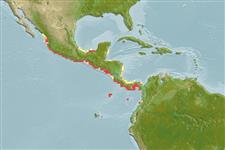Common names from other countries
Issue
This species is placed in Clupeidae in Eschmeyer (CofF ver. July 2013: Ref. 93826), in Pristigasteridae by Lavoué (pers. comm., July 2013).
Environment: milieu / climate zone / depth range / distribution range
Écologie
marin; profondeur 0 - 50 m (Ref. 188). Tropical; 25°N - 3°N, 109°W - 77°W (Ref. 188)
Eastern Central Pacific: Mazatlán, Mexico to Ecuador.
Taille / Poids / Âge
Maturity: Lm ? range ? - ? cm
Max length : 25.0 cm SL mâle / non sexé; (Ref. 55763); common length : 15.0 cm SL mâle / non sexé; (Ref. 55763)
Description synthétique
Clés d'identification | Morphologie | Morphométrie
Épines dorsales (Total) : 0; Rayons mous dorsaux (Total) : 0; Épines anales: 0; Rayons mous anaux: 49 - 51. Belly with about 27 or 28 scutes. Lower jaw projecting, mouth pointing obliquely upward; a distinct toothed hypo-maxillary bone between hind tip of pre-maxilla and lower bulge of maxilla blade; upper jaw not reaching back beyond eye center. Dorsal fin behind midpoint of body; anal fin long, its origin a little before dorsal fin. A silver band along flank.
Occurs in coastal waters (Ref. 9336), including estuaries to a depth of 50 m (Ref. 96339).
Life cycle and mating behavior
Maturities | Reproduction | Spawnings | Egg(s) | Fecundities | Larves
Whitehead, P.J.P., 1985. FAO Species Catalogue. Vol. 7. Clupeoid fishes of the world (suborder Clupeoidei). An annotated and illustrated catalogue of the herrings, sardines, pilchards, sprats, shads, anchovies and wolf-herrings. FAO Fish. Synop. 125(7/1):1-303. Rome: FAO. (Ref. 188)
Statut dans la liste rouge de l'IUCN (Ref. 130435)
CITES (Ref. 128078)
Not Evaluated
Menace pour l'homme
Harmless
Utilisations par l'homme
Pêcheries: pêcheries vivrières
Outils
Articles particuliers
Télécharger en XML
Sources Internet
Estimates based on models
Preferred temperature (Ref.
115969): 25.4 - 28.5, mean 27.8 (based on 54 cells).
Phylogenetic diversity index (Ref.
82804): PD
50 = 1.0000 [Uniqueness, from 0.5 = low to 2.0 = high].
Bayesian length-weight: a=0.00603 (0.00365 - 0.00994), b=3.07 (2.93 - 3.21), in cm Total Length, based on LWR estimates for this species & (Sub)family-body (Ref.
93245).
Niveau trophique (Ref.
69278): 3.5 ±0.5 se; based on size and trophs of closest relatives
Résilience (Ref.
120179): Haut, temps minimum de doublement de population inférieur à 15 mois (Preliminary K or Fecundity.).
Fishing Vulnerability (Ref.
59153): Low vulnerability (21 of 100).
